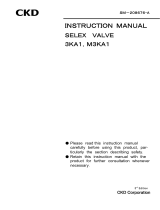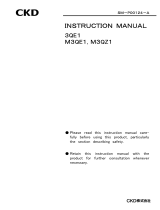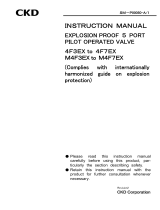Page is loading ...

Please read this instruction manual
carefully before using this product,
particularly the section describing safety
Retain this instruction manual with the
product for further consultation whenever
necessary

1

2

3
’

4
UNPACKING (Section 3)
INSTALLATION (Section 4)
ENVIRONMENT (Section 4.1)

5
INSTALLATION (Section 4.2)

6
PIPING (Section 4.3)

7
WIRING (Section 4.4)
MANUAL OPERATING DEVICE (Section 5.2)
AIR QUALITY (Section 5.3)

8
ELECTRIC CIRCUITS (Section 5.4)
PERIODIC INSPECTION (Section 6.1)
DISASSEMBLING AND REASSEMBLING (Section 6.2)
C
R

9
INDEX
Block Manifold
Manual No. SM-213928-A/2
1. PART NAME AND DESCRIPTION 10
2. INTERNATIONAL SYSTEM OF UNITS (SI) 11
3. UNPACKING 12
4. INSTALLATION
4.1 Environment 13
4.2 Installation Method 14
4.3 Piping 15
4.4 Wiring 18
5. OPERATING RECOMMENDATION
5.1 Operation 24
5.2 Manual operating device 26
5.3 Air Quality 27
5.4 Electric Circuits 29
6. MAINTENANCE
6.1 Periodic Inspection 30
6.2 Disassembling and Reassembling 31
7. TROUBLE SHOOTING 34
8. PRODUCT SPECIFICATIONS AND HOW TO ORDER
8.1 Product Specifications 35
8.2 How to Order 36
8.3 Accessory 39
8.4 Consumable parts 43

10
No. Part Name Description
Valve unit mounting screw
Tow mounting screws are provided for each valve unit.
They are used for mounting the valve unit to one of the
various types of bases.
Valve unit
Air supply or
exhaust block A block with a supply port and an exhaust port.
Connecting key
The key is pushed in after the connection of the blocks
in order to secure the connection.
Mounting screw
DIN rail on the manifold.
DIN rail
End block
It has a function of common supply
/exhaust flow plu
g-
ging.
Riping adapter
(one-touch joint)
Port P is the supply port : Port R and PR is the ex-
haust port : Port A and B is the output port.
Valve block
A block of assembled solenoid valve unit and valve
block.
Partition block
Shuts off the supply and exhaust as required and
is
used for different pressure circuits or the like.

11
In this manual, values are expressed using the International System of Units
(SI).
Use the table below to convert them into values expressed in conventional
units.
Table of conversion between SI units and conventional units
(The values printed in Bolds fonts are values given in the International System of Units (SI)):
Force
N dyn kgf
1 1 105 1.01972 10-1
1 10-5 1 1.01972 10-6
9.80665 9.80665 1051
Stress
Pa or N/m2MPa or N/mm2kgf/mm2 kgf/cm2
1 1 10-6 1.01972 10-7 1.01972 10-5
1 106 1 1.01972 10-1 1.01972 10
9.80665 1069.80665 1 1 102
9.80665 1049.80665 10-2 1 10-2 1
Note 1Pa=1N/m2, 1MPa=1N/mm2
Pressure
Pa kPa MPa bar kgf/cm2 atm mmH2O mmHg or Torr
1 1 10-3 1 10-6 1 10-5 1.01972 10-5 9.86923 10-6 1.01972 10-1 7.50062 10-3
1 103 1 1 10-3 1 10-2 1.01972 10-2 9.86923 10-3 1.01972 1027.50062
1 106 1 103 1 1 10 1.01972 10 9.86923 1.01972 1057.50062 103
1 105 1 102 1 10-1 1 1.01972 9.86923 10-1 1.01972 1047.50062 102
9.80665 1049.80665 10 9.80665 10-2 9.80665 10-1 1 9.67841 10-1 1 104 7.35559 102
1.01325 1051.01325 1021.01325 10-1 1.01325 1.01323 1 1.03323 1047.60000 102
9.80665 9.80665 10-3 9.80665 10-6 9.80665 10-5 1 10-4 9.67841 10-5 1 7.35559 10-2
1.33322 1021.33322 10-1 1.33322 10-4 1.33322 10-3 1.35951 10-3 1.31579 10-3 1.35951 10 1
Note 1Pa=1N/m2
Example (converting a pressure value):
1kgf/cm20.0980665MPa 1MPa 1.01972 10kgf/cm2

12
a) Check the model number imprinted on the product to make sure that the
product you received is exactly the product you ordered.
b) Check the exterior of the product for any damage.
c) Before using the product, read the supplied documentation.

13
4.1 Environment

14
4.2 Installation method
4.2.1 A work space for installation, removal, wiring, and piping opera-
tions should be provided around the installed solenoid valve sys-
tem.
4.2.2 Direct mounting
Use two mounting holes both ends of the DIN rail.

15
4.3 Piping

16
4.3.1 Flushing
Before connecting pipes, flush the interiors of the tubes, solenoid valves, and
connected devices to remove foreign matter.
4.3.2 Blow circuit
Do not open the cylinder port circuit to the air because a drop in the air sup-
ply pressure may cause a malfunction. Select the external pilot type design
instead of the internal pilot type design.
4.3.3 Exhaust port
Minimize the restriction to the flow of the exhaust air because such re-
striction may cause a delay in the cylinder response. If such a delay hap-
pens, the speed needs to be adjusted between the cylinder and solenoid valve.
4.3.4 Pipe connections
(1) Tubes to be used
For use with solenoid valves with one-touch joints, select tubes of the type
specified by us:
Soft nylon tubes (F-1500 Series)
Urethane tubes (U-9500 Series)
(2) For installation at a site that has spatters in the air, select incombustible
tubes or metal pipes.
(3) For a piping used for both hydraulic and pneumatic controls, select a hydrau-
lic hose.
When combining a spiral tube with a standard one-touch joint, fix the tube
origin using a hose band. Otherwise the rotation of the tube will decrease
the efficiency of the clamping.
For use in a high-temperature atmosphere, select fastener joints instead of
one-touch joints.

17
(4) When selecting from tubes commercially available, carefully study the accu-
racy of the outside diameter as well as the wall thickness and the hardness.
The hardness of an urethane tube should be 93 C or more (as measured by
a rubber hardness meter).
With a tube that does not have a sufficient accuracy of the outside diameter
or the specified hardness, a decrease in the chucking force may cause dis-
connection or difficulty in inserting.
Tube dimensions
Outside diameter
mm
Inside diameter mm
Nylon Urethane
4 2.5 2
6 4 4
8 5.7 5
10 7.2 6.5
(5) Minimum bending radius of tubes
Observe the minimum bending radius of tubes. Neglecting the minimum
bending radius may cause disconnection or leaks.
Tube bore Minimum bending radius mm
Nylon Urethane
4 10 10
6 20 20
8 30 30
10 40 40
(6) Cutting a tube
To cut a tube, use a tube cutter to cut the tube perpendicularly to the length
of the tube. Inserting an obliquely cut end of a tube may cause air leakage.
(7) Tube connections
Do not bend a tube immediately at where it is connected to the joint but lead
it out straight from the end of the joint for a length equal to or greater than
the outside diameter of the tube. The tension applied sideways through the
tube should not exceed 40N.
(8) Blank plug to be used
For use with a solenoid valve with a one-touch joint, select the blank plug
specified by us:
Blank plug GWP -B Series
Outside diameter allowance
Soft or hard nylon 0.1mm
Urethane 4, 6 +0.1mm
-0.15mm
Urethane 8, 10 +0.1mm
-0.2mm

18
4.4 Wiring
1) Caution for wiring
(1) When using the small terminal box and water-proof is required, use cab-tire
cords 4 to 6.5 in outer diameter (water-resistance is improved, but not
for outdoor use).
(2) The connector type (C, C1, C2, C3, D, D1, D2, D3) should be used in a place
with little dust and not directly exposed to water and oil.
(3) For the electrical circuit, use a switching circuit free of chattering.
(4) The electrical circuit should have fuses.
(5) Be sure that the operation voltage is within 10% of the rated voltage.

19
2) Wire connection
Name Grommet (standard) Small terminal box Small terminal box
with indicator light
Small terminal box
with surge suppressor
and indicator light
Option
code No code B L LS
Shape
Circuit
Name Plug-in connector C type
with lead wire
Plug-in connector C type
without lead wire
Plug-in connector C type
with lead wire, surge
suppressor and indicator
light
Plug-in connector C type
without leadwire,
surge suppressor and
indicator light
Option
code C C1 C2 C3
Shape
Circuit
(
)
(
)
DC
(
)
(
)
AC
(
)
(
)
AC
Lead wire
300mm
(11/0.16)
Lead wire
300mm
(11/0.16)
(
)
(
)
DC
Red
Black
(
)
(
)
AC
Lead
w
ire
300mm
(20/0.18)
90
/











